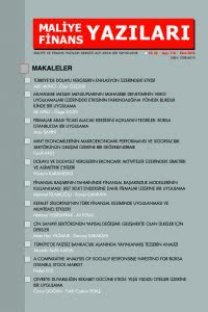A Comparative Analysis Of Socially Responsible Investing For Borsa Istanbul Stock Market
Corporate Social Responsibility, Islamic Finance
___
- REFERENCESABBOTT, W. F., and MONSEN, R. J. (1979), “On the measurement of corporate social responsibility: Self-report disclosure as a method of measuring social involvement”, Academy of Management Journal, 22, pp. 501-515.ALPASLAN A., and AYGÜN M. (2013), “Kurumsal Sorumluluk ve Firma Performansı”, Süleyman Demirel University, The Journal of Faculty of Economics and Administrative Sciences, Vol.18 No. 1, pp. 435-448.ALEXANDER, G. J., and BUCHHOLZ, R. A. (1978), “Corporate social responsibility and stock market performance”, Academy of Management Journal, Vol. 21, pp. 479-486.ATEŞOĞLU İ., and TÜRKER A. (2010), “Konaklama İşletmelerinin Sosyal Sorumluluk Faaliyetlerine Yaklaşımı:Muğla İli Örneği”, Süleyman Demirel University, The Journal of Faculty of Economics and Administrative Sciences, Vol. 15 No. 3, pp. 207-226.BAŞAR B. (2014), “Kurumsal Sosyal Sorumluluk Raporlaması ve Finansal Performans Arasındaki İlişki:Borsa İstanbul’da İşlem Gören Kimya Petrol Plastik Sektörü Şirketleri Üzerinde Bir Araştırma”, Celal Bayar University İİBF , Vol. 21 No. 2.BAŞAR B., and BAŞAR M. (2006), “Sosyal Sorumluluk Raporlaması ve Türkiye’deki Durumu”, Anadolu University, Journal of Social Sciences, pp. 213-230.BERMAN SL, Wicks AC, KOTHA S, JONES TM. (1999), “Does stakeholder orientation matter? The relationship between stakeholder management models and the firm financial performance”, Academy of Management Journal, Vol. 42 No. 5, pp. 488-506.BODİE Z., Kane, A., MARCUS, A.J. (2005), "Investments", McGraw-Hill.BOWMAN, E. H., and HAIRE, M (1975), “A strategic posture toward corporate social responsibility”, California Management Review, Vol.18 No. 2, pp. 49-58.BRAGDON, J. H., and MARLIN, J. A. T. (1972), “Is pollution profitable?”, Risk Management, Vol. 19 No. 4, pp. 9-18.ÇELIK İ., DINÇER H., YILMAZ R. (2012), “İMKB’de İşlem Gören Bankaların Kurumsal Sosyal Sorumluluk Çalışmalarının Finansal Sonuçları Üzerinde Kurumsal Yönetim İlkeleri Çerçevesinde Bir İnceleme”, Beykent University, Journal of Social Sciences, Vol. 5 No. 2, pp. 37-63.
- ÇITAK L., and ERSOY E. (2016), “Firmaların BIST Sürdürülebilirlik Endeksine Alınmasına Yatırımcı Tepkisi: Olay Çalışması Ve Ortalama Testleri İle Bir Analiz”, International Journal of Alanya Faculty of Business, Vol. 8 No.1, pp. 43-57.CINGÖZ A., and AKDOĞAN A. (2012), “İşletmelerin Kurumsal Sorumluluk Faaliyetleri”, Atatürk University Journal of Social Sciences, Vol.16 No. 3, pp. 331-349.COFFEY BS, FRYXELL GE. (1991), “Institutional Ownership of Stock and Dimensions of Corporate Social Performance: An Empirical Examination”, Journal of Business Ethics, Vol. 10 No. 6, pp. 437-444.GRIFFIN JJ, MAHON JF. (1997), “The corporate social performance and corporate financial performance debate”, Business & Society, Vol. 36 No. 1.HEINZE, D. C. (1976), “Financial correlates of a social involvement measure”, Akron Business and Economic Review, Vol. 7 No. 1, pp. 48-51.HILLMAN AJ, KEIM GD. (2001), “Shareholder value, stakeholder management, and social issues: What’s the bottom line?” Strategic Management Journal, Vol. 22 No. 2, pp.125-139.MARGOLIS J, WALSH J. (2001), “People and profits?”, Lawrence Erlbaum Associates: New Jersey.MARGOLIS J, WALSH J. (2003), “Misery loves companies: Rethinking social initiatives by business”, Administrative Science Quarterly, Vol. 48, pp. 268-305.MCWILLIAMS, A., and D. SIEGEL (2000), “Corporate social responsibility and financial performance: Correlation or misspecification?”, Strategic Management Journal, Vol. 21 No. 5, pp. 603-609.
- MODIGLIANI, F., and MODIGLIANI, L. (1997), “Risk-adjusted performance”, The Journal of Portfolio Management, Vol. 23 No. 2, pp. 45-54.
- MOSKOWITZ, M. (1972), “Choosing socially responsible stocks”, Business and Society, Vol. 1, pp.71-75.
- NELSON, Daniel B. (1991), “Conditional Heteroskedasticity in Asset Returns: A New Approach”, Econometrica, Vol. 59 No. 2, pp. 347-370.
- PARKET, R., and EIBERT, H. (1975), “Social responsibility: The underlying factors”, Business Horizons, Vol. 18, pp. 5-10.
- PELIT E., KELEŞ Y.,ÇAKIR M., (2009), “Otel İşlemelerinde Sosyal Sorumluluk Uygulamalarının Belirlenmesine Yönelik Bir Araştırma”, Celal Bayar University, Vol. 16 No. 2.POST JE, PRESTON LE, SACHS S. (2002), “Managing the extended enterprise: The new stakeholder view”, California Management Review, Vol. 45 No. 1, pp. 6-28.ROMAN R, Hayibor S, AGLE BR (1999), “The relationship between social and financial performance”, Business & Society, Vol. 38 No. 1.SHARPE, W. F. (1966), “Mutual fund performance”, The Journal of Business, Vol. 39 No. 1, pp. 119-138.
- SOLOMAN, R., and HANSEN, K. (1985), “It's good business”, New York: Atheneum.STURDIVANT, F. D., and GINTER, J. L. (1977), “Corporate social responsiveness: Management attitudes and economic performance”, California Management Review, Vol.19 No. 3, pp. 30-39.ULLMANN, Arieh A. (1985), "Data in search of a theory: A critical examination of the relationships among social performance, social disclosure, and economic performance of US firms.", Academy of management review, Vol. 10 No.3, pp. 540-557.http://www.borsaistanbul.com/en/indices/bist-stock-indices/corporate-governance-index (accessed February 10, 2016).http://www.borsaistanbul.com/en/indices/bist-stock-indices/bist-sustainability-index (accessed February 10, 2016).http://www.katilimendeksi.org/subpage/116 (accessed February 10, 2016).
- ISSN: 1308-6014
- Yayın Aralığı: Yılda 2 Sayı
- Başlangıç: 2008
- Yayıncı: Maliye ve Finans Yazıları Yayıncılık Ltd. Şti.
Çevreye Duyarlılığın Rekabet Gücüne Etkisi: Yeşil Yıldızlı Oteller Üzerine Bir Uygulama
Öznur DOĞAN, Fatih Coşkun ERTAŞ
Dolaylı ve Dolaysız Vergilerin Ekonomik Aktiviteler Üzerindeki Simetrik ve Asimetrik Etkileri
Mehmet İSLAMOĞLU, Samet ÇANKAYA
Firmalar arası Ticari Alacak Kredisini Açıklayan Teoriler: Borsa İstanbul’da bir Uygulama
Türkiye’de Faizsiz Bankacılık Alanında Yayınlanmış Tezlerin Analizi
Çin Sanayi Sektörünün Yapısal Değişimi: Gelişmekte Olan Ülkeler için Dersler
Mete Han YAĞMUR, Gencay KARAKAYA
Türkiye’de Dolaylı Vergilerin Enflasyon Üzerindeki Etkisi
Kefalet Sigortası'nın Türk Finansal Kesiminde Uygulanması ve Muhtemel Etkileri
